Werewolf: The Apocalypse 20th Anniversary Edition by Kurieg
Foreword and Comic
Original SA post
In 1992, White Wolf published Werewolf: The Apocalypse as a sister gameline to their flagship Vampire: The Masquerade. It was a different game in a lot of ways, for one up until that point, while werewolves did exist in Vampire's world, they were known as Lupines and were basically nigh-unkillable faceless plot sticks used as a threat to keep Vampires in the cities. The Garou of W:tA were much different than Lupines, for one they were playable, and they actually had a culture and society of their own. The gameline went through some growing pains as it tried to find it's own theme, usually falling into the unfortunate trap of "just make them angsty vampires with fur", but after a restructuring and a new line developer it started to move off in its own direction.
In 2004, White Wolf published "Apocalypse", the last game for the Werewolf gameline. It provided a couple of different scenarios for how the world where Werewolf takes place would end, but the answer was pretty clear: Werewolf the Apocalypse, as a gameline, was over. Shortly thereafter came the New World of Darkness, with it's own Werewolves, the Forsaken. To say it was poorly received by some would be an understatement but after an initial growing pains period it too improved. But things were going to get even more confusing. In 2006, White Wolf merged with CCP, under the auspices of creating a World of Darkness MMO while White Wolf continued to produce books. Which worked fine until 2011, when almost the entirety of CCP's publishing staff was let go, including the Werewolf line dev. Which seemed to be the final nail in the coffin of Werewolf: the Apocalypse.
But then in 2012 Richard Thomas announced Onyx Path Publishing, made up of old White Wolf employees, which had licensed the rights to continue publishing White Wolf's material. Vampire 20th anniversary addition was announced and released shortly before this, followed by the book I will be reviewing today.
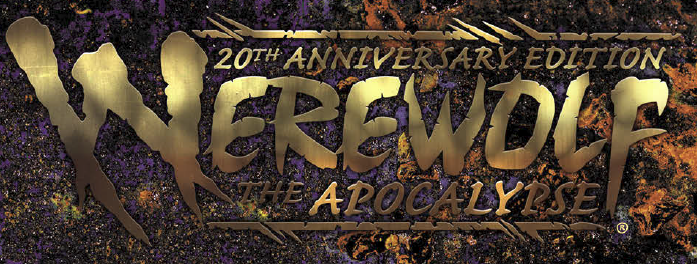
Part 1: Foreword and Comic.
quote:
Those of you holding this book in your hands probably need no introduction to Werewolf: The Apocalypse. You already know the savage horror and the joyous exultation of Rage. You know the tragedy of a warrior-people who turned on their own, and the one last hope that still burns as long as their hearts possess the will to fight. You know the glory of a struggle against a god of Entropy and Corruption, and the triumph of delivering just one small mortal soul. You know the pain of a world and the beauty of the spirit.
This book is for you. Werewolf: The Apocalypse - 20th anniversary Edition. The Prophecy of the Phoenix will be fulfilled.
I'm going to be using this book as a guideline, glossing over the crunch except where it might be interesting to a new or returning player, and expanding on the fluff regarding the tribes and the universe.
Now like any other White Wolf book, it opens with a short story, this time in comic form. I won't be copy/pasting the whole thing as it is long and requires a fairly large picture size for the text to remain readable, curse you vectorized fonts.
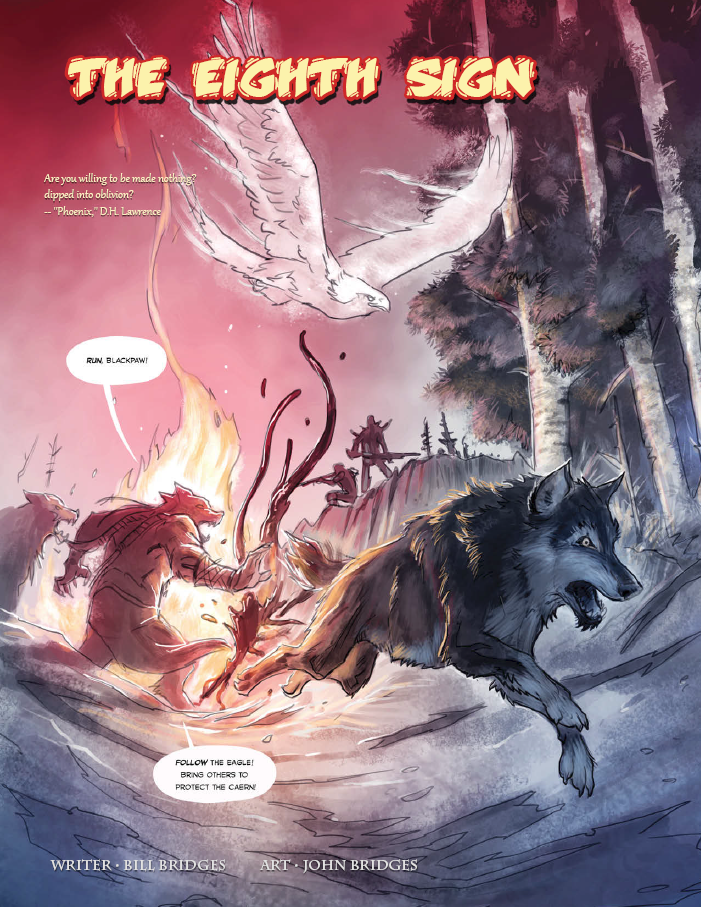
Meet Blackpaw and his spirit guardian Golden Eagle. Blackpaw's caern in Yellowstone is being attacked by Wyrm Forces, and they're holding them off long enough for Blackpaw and Golden Eagle to get away and get help. Blackpaw takes a silver bullet to the shoulder, and Golden Eagle picks him up and takes him into the umbra, and then opens up a moon bridge to the Caern of the Green in Central Park.
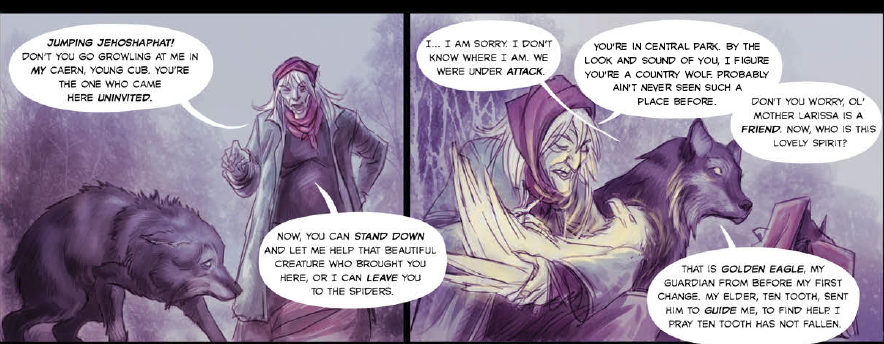
Mother Larissa is the ranking member of the Bone Gnawer tribe in New York, and the Caern of the Green is also a pretty big deal. Larissa notes that just any old guardian spirit wouldn't have been able to bring them this far and straight to her in such a protected place, so there's something weird going on.
It cuts to some time later. Blackpaw has apparently told his story to every Garou that would listen, including Mari Cabrah, one of the highest ranking Black Furies in existance, and a packmember of the current King of the Garou Nation, Albrecht. Also present is Kleon Winston, leader of the Glass Walkers in New York City. Kleon does some internet investigating and discovered that most of Blackpaw's pack is dead, save Ten Tooth, whom Pentex have taken north into the Alberta tar sands. Blackpaw tells them that there's a bane bound under the Bison Rock Caern, and that Ten Tooth knows the glyph that will allow Pentex to unseal it. In the meantime Larissa has been stitching up Blackpaw's wound and discovered something.
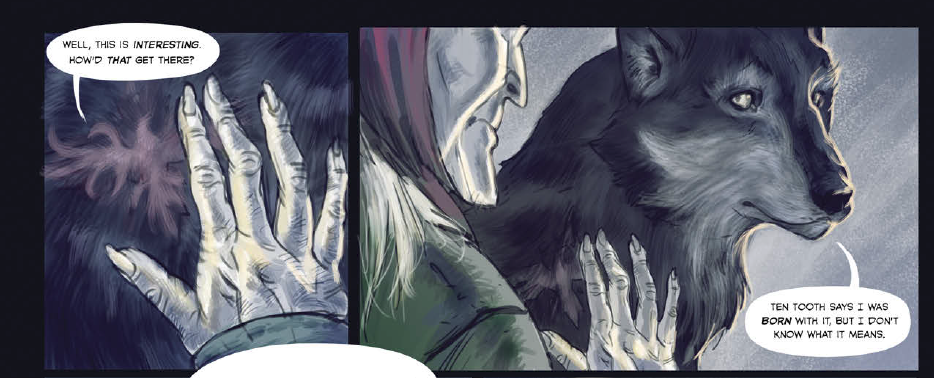

Mari decides they can't wait for Albrecht to gather a force big enough to take back the Caern, and decides the three of them will go to Alberta and save Ten Tooth. Unfortunately, the nearest Caern to the tar sands is a blighted hellhole, and all it's defenders are dead. Needless to say they're not happy about this situation, but Golden Eagle intervenes.
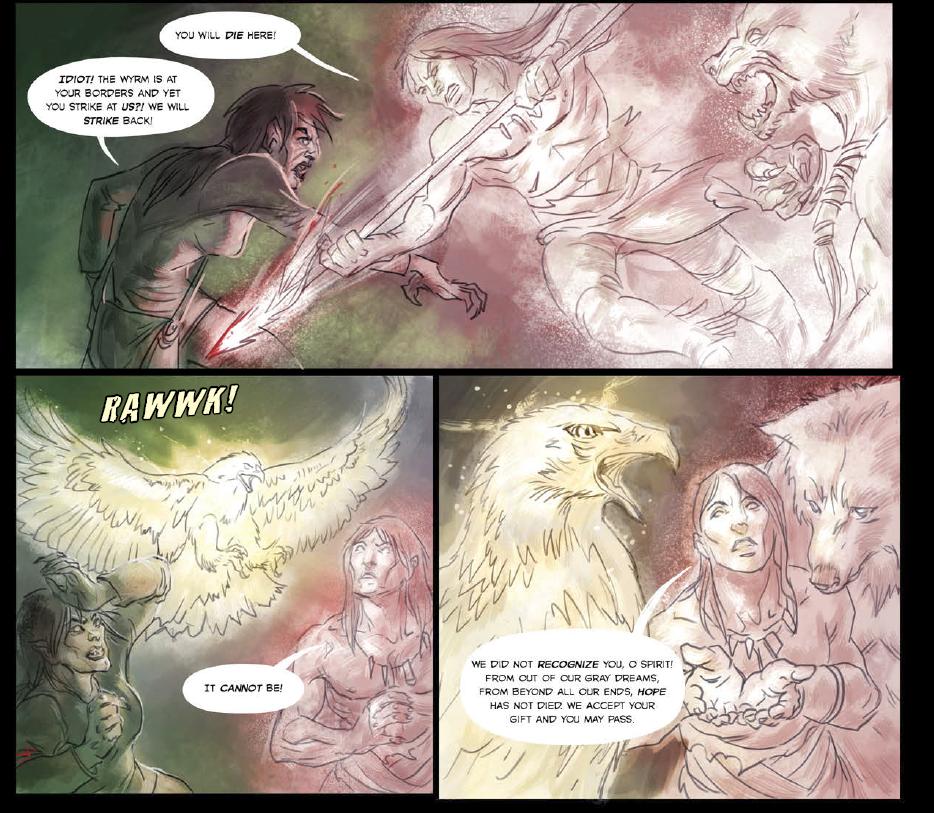
Whatever could this mean.
The three get captured soon after entering he Pentex grounds, however, because apparently the Silver Bullet contained a nanotech tracer or something. They're caught, put in silver chains, and brought before Magda and Francesco, two of the heads of Pentex, who are currently gloating over their impending victory to Ten Tooth. After a quick big of gleeful cackling about the capture of Mari Cabrah, Francesco resumes telling Magda about the Prophecy of the Phoenix.
A note about the Prophecy of the Phoenix, it's basically the Werewolf Book of Revelation, a road map to the end times that will inevitably destroy the world.
The Prophecy posted:
Phoenix took me.
Carried me in his claws.
High above the world.
So that I could see beyond tomorrow.
And I looked.
I beheld the future.
I saw the decimation of our kin. Hunted beyond hunting, death beyond death, to the last one.
There were no more children, or grandchildren, or fathers, or mothers.
This was the first Sign that Phoenix gave to me, that the Children of the Weaver, the Humans, would give to us, the Garou.
I looked.
I beheld the future.
I saw the Children of the Weaver birthing.
A great tide of Humans, rising.
I saw more and more, until Gaia groaned at having to carry them all. Their houses overrunning, their rakes raping, their hands clawing at the parched earth, trying to feed from her.
This was the second Sign of the last days, that Phoenix showed me, that the humans would do.
I looked again.
I beheld the third Sign.
So many. So many children. So many humans. And they fell against each other, one to one, and the Wyrm brought forth corruption and gave each a measure.
And the strange Fire I saw, out of control, the great Plume rising over the wilderness, spreading death wherever it shone in that dark and cold land. And I heard the agony of the Sea as She keened, for some drunken fool had poured a lake of black death out upon her.
I turned my head away in disgust but I could not help but look again.
I beheld then the fourth Sign.
The Wyrm grew powerful; its wings fanned the breezes of decay. It spread its diseases and they were horrible: the Herd became afflicted with diseases of the head and the blood.
Children were born twisted. Animals fell sick and no one could cure them.
In these final days, even the Warriors of Gaia could not escape the palsied talons of the sickness-bringing deathbird.
A tear in my eye, I looked again and the Phoenix showed me the fifth sign.
I saw other Plumes rising like death-spears toward the beautiful sky, piercing it, letting Father Sun burn and parch Gaia. The air grew hot; even in the darkness of Winter it was warm.
The plants withered in the sun. A cry of pain and disease arose from the dying forests; as one the relations cried out tears of mourning.
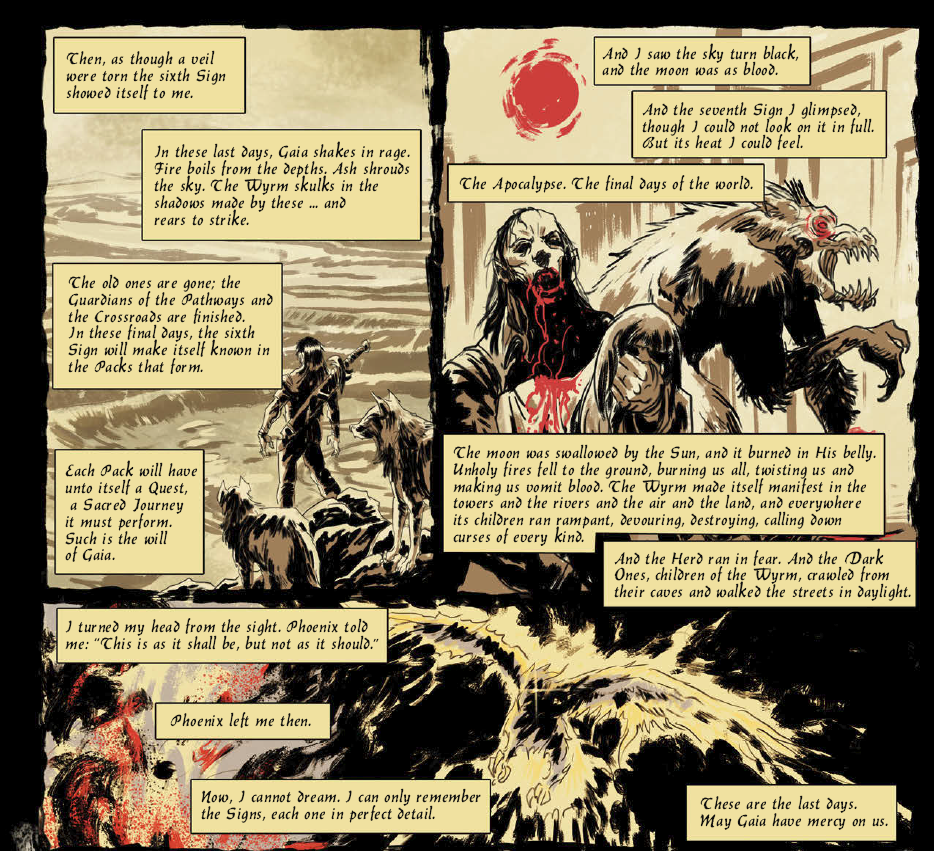
Francesco is gloating since the Garou themselves say the Wyrm is going to win, since Phoenix, the spirit of life after death basically told them "you're all going to die horribly". Even better is the fact that Mari brought Blackpaw back with her, because his birthmark is in fact the glyph key he needs to release the beast bound under the Caern. In a startling bout of competency, he takes a picture of it, texts it to one of his subordinates, then starts choking Blackpaw to death so that no one else can do anything about it.
But then Golden Eagle saves them, because as probably everyone's guessed by now, Golden Eagle is actually Phoenix
 . He burns their bonds off of them and allows them to escape as the Ghosts from earlier start attacking to cover them. Blackpaw asks Phoenix why he spent so long watching after him and Phoenix shows him an 8th omen, the Garou Victorious.
. He burns their bonds off of them and allows them to escape as the Ghosts from earlier start attacking to cover them. Blackpaw asks Phoenix why he spent so long watching after him and Phoenix shows him an 8th omen, the Garou Victorious.
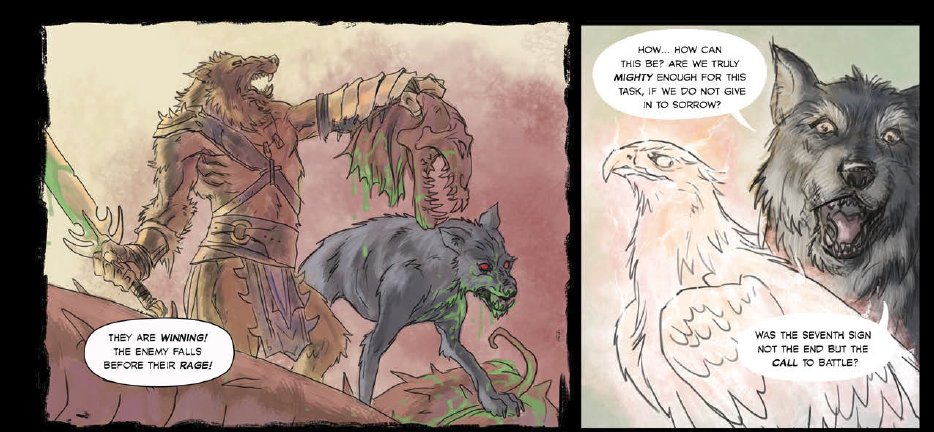
Basically "What part of 'not as it should be' did you guys not get? Fuck."
Ten Tooth expands on this to say that the 8th sign is Blackpaw's birthmark, and it marks him as the Son of the Phoenix Spirit. Not figuratively, literally. Because this is W:TA and yes that can happen. Phoenix finishes opening the portal back to the Caern and they step through into
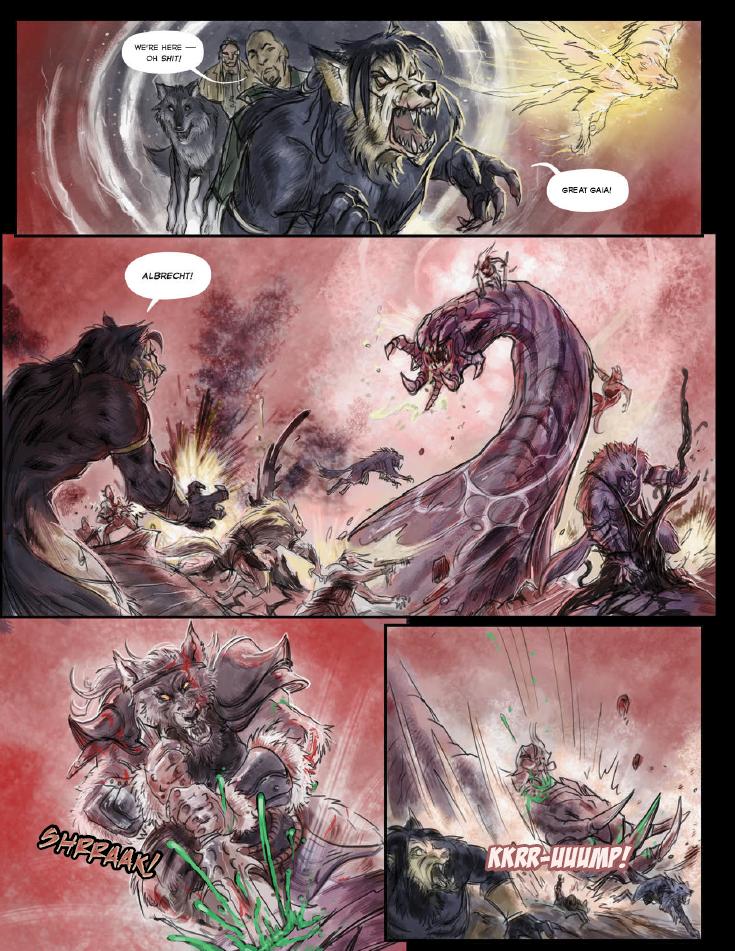
The arrival of Phoenix rallies the Garou to rout their enemies and they claim victory. Also Albrecht takes some time to show why he's my favorite NPC of any White Wolf storyline.
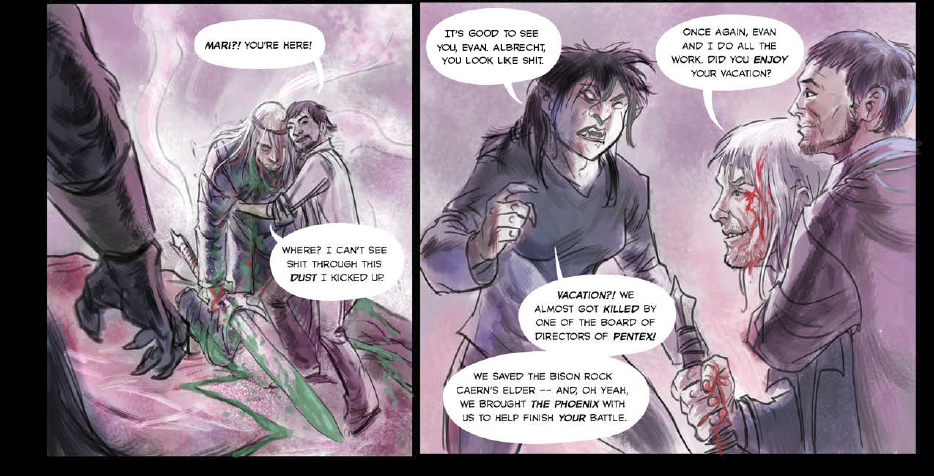
Look at that shit eating grin.
Ten Tooth tells Blackpaw that he can't stay anymore, that he has to go back with the others and tell the tale of the 8th sign. And make sure that the Garou know that they can and will win the battle as long as they don't lose hope.
Ultimately I like the comic, the art style isn't bad, and the writing isn't terrible. The only problem is that a lot of the impact of it is lost on people with less background knowledge. They spit out names like Kleon and Mari Cabrah and without knowing who you are you don't know why you should care. There's also the note about the 8th sign. Which is basically White Wolf going "Yeah we kind of set things into a Nihilistic spiral towards the end of the game line, so we're shifting things towards the more hopeful side of things. Shits still fucked but it won't always be."
The next chapter is the intro, which is short, but also segues into the 1st chapter, which is not. Meaning the next update will be covering 70 pages worth of content.
It might take a while
World of Werewolves
Original SA post
Part 2: World of Werewolves
So it's been a month and a half, whoops. Blame videogames and burnout. The last post is Here
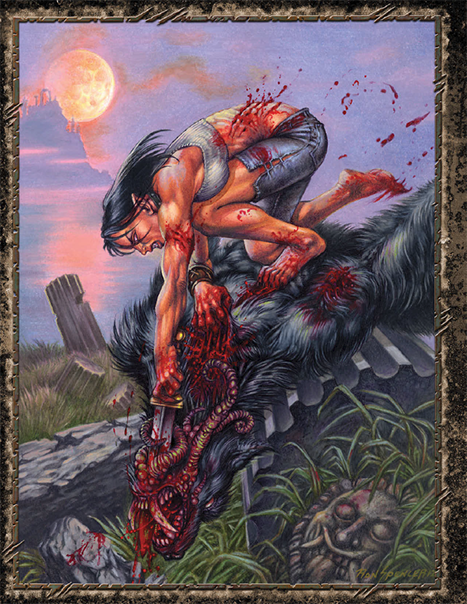
Here's our intro to Ron Spencer, we'll be seeing a lot of him, and this is a good thing.
Intro- aka What the hell is a Garou?
As I mentioned in my last post the Garou had their genesis in the Lupines from Vampire: The Masquerade. Lupines had little motivation beyond "Kill Vampires" and were designed to perform that purpose very well, to the point that they were nigh unkillable unless the players were designed to kill Lupines. Werewolf: the Apocalypse gave them a purpose beyond killing Vampires, or at least a reason for doing so, and created the spirit world on which many of the following gamelines would either rely on, or at least utilize to some degree.
Being as there are dozens of pop-culture properties that have touched on Werewolves in the past 20 years, they do take some time out to address what Werewolves are and are not.
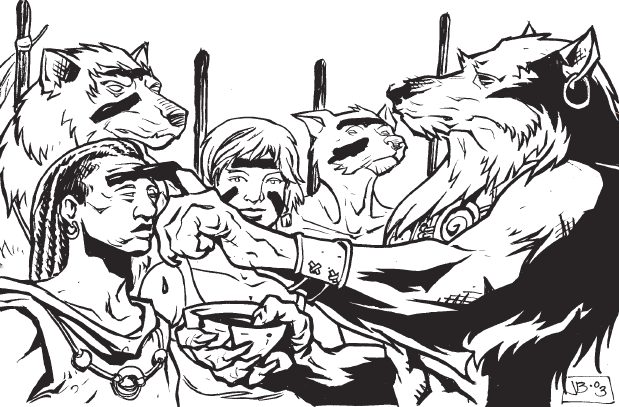
-
They are not the victims of a curse
Most Garou see their nature as a blessing, and while they are capable of doing horrible things against their will, that's more a factor of their unnatural (literally) anger than a malevolent will guiding their actions.
-
They are not contagious by bite.
Werewolves are born, not infected. In the olden days Garou would sometimes hunt down and harry nascent Werewolves to try and chase them away from populated areas before their change, which may have given rise to the myth.
-
Their powers are not granted by a magical spell or object.
They do have animistic magic and powerful spirit-bound items, but that's a result of their nature, not the cause of it. Werewolves are half-spirit and can interact with the spirit world and its denizens.
-
The full moon does not force them to change, nor can they only change form under the full moon
They can change shape whenever they damned well please, but some other circumstances can force a change.
-
The full moon does not make them mindless beasts
Werewolves have hair trigger tempers, and they do get more agitated on the full moon. If they do lose their temper they can go into a mindless frenzy but it takes more than just seeing the moon to do it.
-
Werewolves ARE vulnerable to silver.
But you don't need it to kill one. They heal incredibly quickly most of the time but they aren't immortal. Toss one off a building or hit it with a semi and it will probably die, if it doesn't though they'll be back up and running in a few minutes to an hour. Silver wounds, however, heal as fast as a normal wound would on a human, if maybe slower.
-
Werewolf packs are different than wolf packs
Wild wolf packs are usually family units, with a mom, dad, and their kids that haven't been kicked out yet. Werewolf packs have Alphas, betas, omegas, etc. Because having a chain of command that you can refer to is nice when the ground opens up and Yog Sottoth's younger brother comes out.
-
Werewolves do not have any "tells"
If a werewolf is angry enough they will make people shun away from the creepy scary guy, but otherwise a Garou is no different than any other human or wolf.
There are a few things that are Unique to the Garou as well.
First is Breed , this is the form the Garou was born in, Homids were born human, and Lupus were born wolf, either to a Garou and a normal parent, or to a Kinfolk bloodline. Kinfolk are humans/wolves that are descended from the Garou, but are not Garou themselves. They do possess a bit of Werewolf blood in them, not enough to change but enough to count in certain situations. Garou-Garou pairings do also result in children, but that's something we're going to address later.
Second is Auspice , the moon phase a Garou was born under. Luna affects Garou differently depending on when they were born. The fuller the moon, the more Rage they will have, with Full Moon children being warriors amongst warriors.
Third is Tribe , the 'family' to which they were born. Most of the time Tribe is genetic, as it's determined by kin lines, territory, ideology, and their spiritual totem. Sometimes Garou can 'defect' but it's rare.
The rest of the intro mostly discusses how to use the book, and sources of inspiration to look for ranging from the obvious (American Werewolf in London, Dog Soldiers, the Howling) to the less obvious (Princess Mononoke, Lovecraft, Japanese Horror and Russian Fairy Tales).
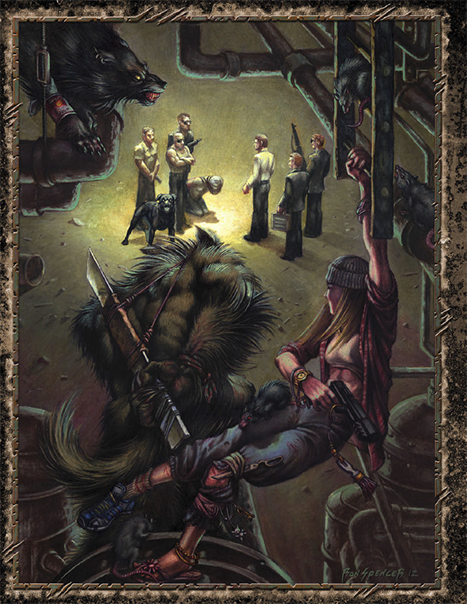
Chapter 1:A World of Darkness
So what is the World of Darkness anyway? The book goes into 3 pages of poetic description that's honestly a bit hard to follow and summarize. The short answer is "Our world but worse." People are meaner, corporations are crueler, diseases are more virulent, and corruption of all kinds is more rampant. However, in Werewolf: The Apocalypse, most of these events have a reason. The spirit world exists in the World of Darkness, and one of the most powerful denizens of this world is the Wyrm, it is corruption and destruction incarnate, and would like nothing more than to see all of reality ground into a suffering paste before its dissolution into nothingness. Its minions work to this end, whispering in peoples ears, or possessing them outright to do its bidding in the physical world.
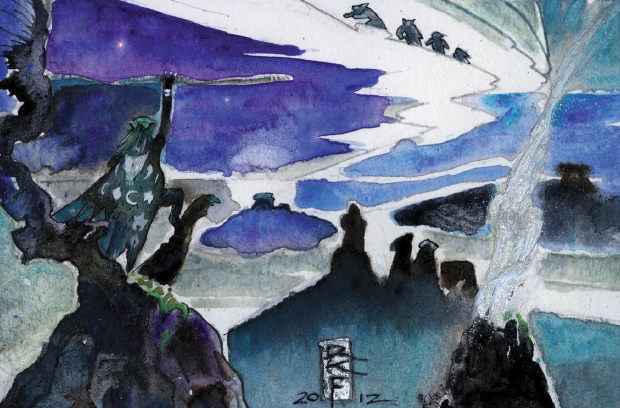
Caught Between Worlds
Garou are caught between worlds, yes, but they're cuaght between a lot of worlds. Human and Wolf, Civilization and Nature, Material and Spirit. As human populations grow, wolf populations dwindle. As cities expand, nature shrinks. As the world becomes more industrialized and globalized, the spirit world dies. The point is that a Werewolf should never be allowed to live solely in one world, even the most hidebound city dweller will sometimes need to visit the wilderness.
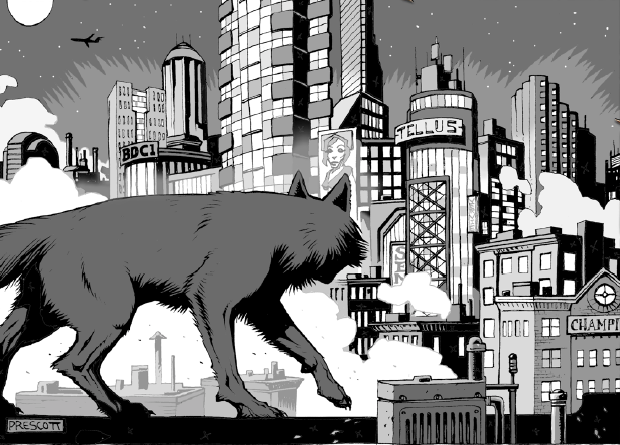
Urban Hell
In the World of Darkness, cities are not nice places to be, and the Garou tend not to look upon them favorably. Cities are like temples to the power of the Wyrm, people are miserable, and that misery turns into apathetic contempt for the rest of the world. Sure they could recycle, but that takes time and goddamn it the garbage can is right there. Corporations aren't much better (most of the time, there are exceptions) and the quickest path is usually the one most damaging to the world at large. Cities are also nexuses of sensory input. Noise is everywhere, smells are everywhere, people are everywhere. This makes it somewhat difficult for a Werewolf to stay sane.
There are two tribes that do make the city their home and thrive there, the Bone Gnawers and the Glass Walkers. They've found urban spirits and made them their allies, they've cultivated the spiritual landscape of the cities and found them as vibrant as any natural ravine. It's definitely not for everyone though.
Primal Wilderness
While the Garou revere nature, nature doesn't really revere back. Animals give them the deference due any predator, but quicksand or a cold snap can kill them just as well as anything else. The wild is a fight to survive and it's a fight most Garou enjoy and excel at, as well as the fact that it's their born duty to protect and maintain the world's wild places.
The Spirit World
What's the sense in having a rich fleshed out spirit world if you can't go there? Behind (or beside) the physical world lies the Umbra, any werewolf can go there as they are half spirit, but they're still just beginning to understand it. Everything has a spirit, wind, water, oil, plastic, electricity, glass, all exist in the Umbra. "Near" the physical world, the umbra is a reflection, spirit forests abut spirit cities, but you can go deeper into the umbra where concepts hold more sway than knowledge. Is there a realm of infinite lettuce? Maybe. Will you find it in your lifetime if you look for it? Probably not.
Rage and Gnosis
Rage is the term the Garou use to refer to their anger. The game refers to it as primal fury, the fight or flight response writ large. It's a visceral response to anything that even slightly upsets them and it's what makes them dangerous. A Werewolf at their calmest is still a potential powder keg, some are just better at coping than others.
If Rage is anger, Gnosis is faith, their appreciation for the mysteries of the spirit world and their wonder for the spirits. It's what allows them to befriend totem spirits and learn the gifts and magic that are their birthright.
Mythic History
There are a lot of differing origin stories for how the world was created. There are thirteen tribes of Garou, not to mention the dead tribes or all the other shapeshifters that inhabit the world. All of them have had oral histories of the creation of the world. And there have been dozens of authors across the games 20 year lifespan giving their own interpretations of these oral histories. W20 gives a brief (if woefully incomplete) history of the world, and most of my time these past few weeks has been trying to figure out what to add, expand upon, or remove to get the point across without confusing people.
First there was Gaia, and Gaia was alone. So Gaia created everything else, the physical world and the spirit world, spirits, animals, plants, everything, at the center of it all was Gaia, who became the planet on which we live. Chief amongst the spirits were the 3 primal forces, the Triat of the Wyrm, Weaver, and Wyld. The Wyld was the primal force of creation, spawning an infinite number of creatures and spirits and ideas. The Weaver was the primal force of definition and form, choosing from amongst the Wylds infinite creations and giving them shape and purpose. The Wyrm was the primal force of Balance and Entropy, ensuring that neither the Wyld or Weaver got to powerful by destroying the leftovers of the Wyld's creation and ensuring that nothing the Weaver made stayed around forever. The act of creating/birthing everything left Gaia rather tired, so she decided to sleep.
While Gaia slept, the Weaver got an idea to create a better kind of creature, pulling on the Wyld and Wyrm to create a creature which possessed the forces of Creation, Definition, and Dissolution.

Turns out it's man.
So Gaia wakes up, and does what any concerned mother would do when she finds out that her children have gotten into the carcinogens and the family pet now has sentience, sapience, and has driven a few species to extinction; freaks the fuck out. The Weaver, Wyrm, and Wyld don't take this very well and go off somewhere to sulk, while Gaia tried to figure out what to do with mankind. She didn't want to kill them outright, but they needed to be taught and kept in line.
In the meantime, the Weaver was kind of annoyed. Gaia had punished it unfairly for only doing what it was meant to do, in addition the Wyrm kept on destroying all the neat things it made. So the Weaver tried to wrap the Wyrm up in its webs. The wyrm didn't notice until it was too late (it was being angsty too) and then started thrashing in it's new prison. The webs cut deep into it's hide and it was driven mad with pain, thus the balance wyrm died and the Destroyer Wyrm was born. This corruption seeped into the pattern web of the Weaver and drove it mad as well, trying to calcify everything in eternal stasis.
Gaia realized that things were getting worse and needed to do something about it, fortunately the Triat had given her something to work with. Gaia took the best traits from man and a couple of different animals and created the various Changing Breeds (which will be gone over later in more detail, for now it's just important that they exist), the various spirits were eager to grant their blessings to Gaia's new children, and some were granted favor by Helios the sun, others by Luna the moon. The Garou were amongst those blessed by the Moon, obviously, and were tasked with being Gaia's protectors. The changing breeds gathered humans into herds and taught them the ways of the world/used them for breeding stock. As well as culling them when they grew too numerous, this was known as the Impergium.
The War of Rage
Then the War of Rage happened, who started it and why varies, but it was a brutal fight between the various changing breeds over who could do what job better than the other guy. What is known is that the Garou "Won". Two Changing breeds were wiped out entirely, others were driven into hiding, and others were reduced in numbers enough that they wouldn't recover for a very long time. Of course this had distracted all the changing breeds from their tasks regarding humanity, who had grown numerous in the meantime and built cities. More importantly someone had told them about Silver, and they had had enough of their Werewolf Overlords.
The Concord
The Werewolves gathered together to discuss what they were going to do about their upstart charges. Some wanted to slaughter them wholesale, others thought that the humans were somewhat justified in their anger because the Garou had been killing them for centuries, a majority wanted at least some kind of retribution to show humanity its place. As the arguments continued the various Tribes started to form out of the arguing groups. It took months but eventually they reached the agreement known as the Concord. Humanity would be left to their own devices, with Werewolves trying to guide and check them from the shadows. Garou would keep their own society separate from humanity, taking their mates from the best and brightest humans had to offer. But they would never again take an overt and active role in the course of human destiny. The Western Concordiat was born, and Werewolves faded from the memory of mankind. But mankind still has that instinctive fear of what is lurking in the dark.
Cities grew, and with them the strength of the Weaver and the Wyrm. Cities created their own spirits, and their own problems, and somewhere along the lines Vampires showed up and started encouraging the growth of cities in their own way.
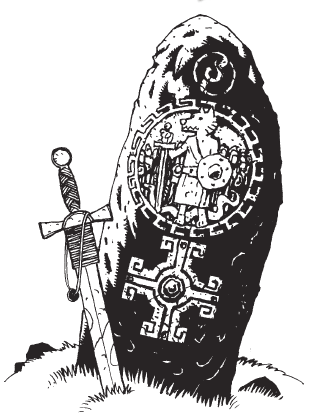
The Fall of the White Howlers
The White Howlers were a tribe of Werewolves in what is now Scotland, claiming their kin from the native Picts. They were brave, headstrong, warriors renowned for sending their cubs deep into the dens of the Wyrm to combat what they found within. Of course, sending your young to fight beasts unknowable to prove their worth started taking its toll on them. Combined with the fact that the Picts were losing their standing in their homeland, the Howlers gathered together in one last push to try and reclaim glory. The entire tribe rose up as one and descended into the deepest Wyrm pit they could find. The Howlers did not come back out, the Black Spiral Dancers did. Corrupt and insane, the Wyrm had claimed an entire tribe of Garou for its own.
The Fall of the Croatan
Scholars of early colonial America might recognize the name Croatan. In the World of Darkness they were one of the three "Pure Tribes" that emigrated over the land bridge into prehistoric North America. But the White Man came, and with it suffering and disease for the native peoples. Enough of it that it actually manifested as an incarnation of the Wyrm, the Eater-of-Souls. The Croatan decided to make a stand, and at the Roanoke colony on the Carolina coast, the Croatan sacrificed themselves to protect their homelands. Overnight the tribe was gone, but so was the Eater-of-Souls.
The War of Tears
If you read my F&F of Rage across Australia you know what happens here. The description given is mercifully brief and to the point. European Garou came to Australia, found the Bunyip Werewolves there already. The Bunyip bred with Thylacines and the Aboriginal people of Australia. As the Europeans oppressed the native peoples, the Bunyip started to fight back, and the Garou were manipulated by the Black Spirals into declaring war on the whole tribe. Now the Bunyip are all dead, bringing the number of remaining Garou tribes to 13.
Becoming Garou
Werewolves are born, not bitten. Cubs are descended from another Werewolf somewhere in their ancestry, if not the children of a Werewolf directly. They're born a normal human or wolf (depending on their mother) and are practically indistinguishable until their first change hits shortly after puberty. And while this happens further along for Humans than Wolves, it's still a rather traumatic experience all told. It's also not a guarantee. The children of a Werewolf and a normal human/wolf only have a 10% chance of being Garou. The children of two Werewolves will always be Garou but that has it's own problems, in addition to violating some of the commandments from Gaia.
Kinfolk
The children that don't change, and their descendants, are known as Kinfolk. They carry the "Werewolf Gene"(as much as a combination of Physical and Spiritual heritage can be called a 'Gene') but will never undergo the change. Some tribes see them as revered children, as it's not unheard of for a Garou to undergo a change late in life. Rare, but not unheard of. Others see them as breeding stock, those that don't change probably never will and they aren't getting anything by coddling them. It's worth noting that you're either born Garou, or not. This isn't like Werewolf the Forsaken where anyone can turn into a Werewolf depending on how the Moon is feeling that day. It's just that some people apparently lead very boring lives up until their mid forties when suddenly someone pisses them off enough for them to change.
Wolf kinfolk are especially rare and treasured, as wolf territory and population are dwindling, and not many Human born Garou see much merit in taking a wolf as a mate. Tribes with heavy Lupus population take special care of their wolf kin, but any tribe with Lupus kinfolk are willing to go to war if they are threatened in any way. Sometimes Garou assign spirits known as Kin-Fetches to watch over their human kin and alert them if any show signs of changing. They're not infallible, or very bright and can be distracted or destroyed before their purpose is served.
Cubs
"Cub" is a catchall term for either a pre-change Garou, or a Garou that hasn't accepted their place in Garou society. Since it's almost impossible to tell who's going to change beforehand, it's usually used retroactively. As mentioned, the change happens shortly after puberty in most cases, though even before that kinfolk often display "strong emotional responses, fits of temper, difficulty fitting in with their society, strange dreams, and odd fixations. In human society the Kinfolk might be wrongly diagnosed with mental illness or wind up in detention". You know, normal adolescent power fantasy stuff. Don't worry kid, the only reason the bullies pick on you is because you're actually a werewolf! In wolf society this either leads to the kinfolk being driven from the pack, or dominating their relatives if they're strong enough.
In either case it culminates in the First Change. The kinfolk shapeshifts for the first time, usually in response to a threat or other intense stimulus. They take on the deadly war-form and "the werewolf takes out a lifetime of frustration, rage, and barely-repressed feelings of being wrong at whatever is in her immediate area". More adolescent power fantasy stuff, (Killing bullies in a violent first change was a common trope in first time Apocalypse characters, along with trench coats, mirror shades, and katanas). If they're lucky, a local pack will find and subdue them before they wreak too much havoc. If they're unlucky they change alone and have to figure out how to calm themselves down on their own. If they're really unlucky, the pack that finds them are Black Spiral Dancers. In years past it wasn't uncommon for there to be Packs devoted to patrolling an area and hunting down and subduing newly changed cubs. Nowadays it's usually a single put-upon Theurge keeping track of dozens of Kin-Fetches if it's anyone at all.
Sometimes it just so happens that a Kin-Fetch, Werewolf, or other spirit finds a Garou pre-change and is able to inform a local pack to come and rescue(kidnap) the kid before they change, allowing them to change under somewhat controlled conditions. Of course there are some Garou that feel this just makes them 'soft' as killing someone in the violent throws of rage is just what Garou need to understand their new lives.
Coming of Age
Once a cub has been found, the rescuing Garou take them to a sept. There they prepare for the Rite of Passage. Part of it is learning the ways of Garou common to all tribes - the Litany, stepping into the spirit world, controlling the change, learning magic from spirits - but also learning about the various tribes (colored by the biases of the Garou that found them) before choosing which one to join. If you're of Pure Breeding you're probably already earmarked for one of the tribes, and some tribes keep meticulous records of bloodlines which basically means the choice has been made for you.
Each tribe has their own traditions for the Rite of Passage, which is both an adulthood ritual as well as the prospective cub proving their worth to the Tribe. There are two basic options. One: approach the tribal elders alone and they'll probably send the cub off on a quest appropriate to their chosen Auspice or Tribe. Usually they'll just go to Option Two: send them off to a sept where lots of cubs await their Rite of passage. Once enough of them are gathered they will be sent off on a quest to test their ability to work together and resolve their differences. Afterwards they may decide to keep working together and form a pack (this is the W:tA equivalent of 'you all meet in a tavern'). In any case the elders send spirits along to watch over them, make sure they don't get themselves killed, and most importantly to verify the greatness of their deeds. Once they return they become Cliath and join their respective tribes formally.
Breeds
In werewolf society, who your parents are accounts for a lot. Not just your standing in society but what you're born as . If your mother was born human, you're a Homid. If your mother was born a wolf, you're a Lupus. If both of your parents were Werewolves, you're a Metis.
Homid
The vast majority of Garou are human born nowadays. They don't always integrate that well with their peers growing up, and with human society in general. "They understand that human society has rules and a certain set of expectations but they often find them strange, unfair, or just annoying. Some mask it better than others, but the first change usually brings relief." Regardless of if you take this at face value or not, transition to Garou society isn't easy. Unless they had kinfolk parents that were in the 'know' they probably don't know much about the way werewolves do things. And unlearning habits and things learned in school can be just as difficult as learning a healthy respect for nature and an understanding that the world is literally alive. Some Garou think that even though humans are the ones who ruined the world, they're still the best hope to fix it, and keep their ties with society. To have any impact at all they'll need to move in human circles.
Lupus
A pre-change Lupus is smarter than its peers, though it doesn't come into full human intelligence until it's first change. At that point it's either relieved at it's sudden understanding of why it is different, or horrified that it can now understand why it's different. Understanding the Garou language comes fairly naturally to all werewolves, but it's still somewhat difficult to explain to a wolf what words mean, not to mention what a "word" is. Human languages are more difficult still and it can lead to stilted caveman speech or just avoiding human contact at all. Adding to that is the difficulty of learning human social cues. Baring teeth is friendly to humans but hostile to wolves, and yes, newly changed Lupus do try to sniff humans butts to greet them. For all the difficulties in communication they do bring an understanding of the natural world that Homids lack. They don't romanticize the wild, they just understand it.
Metis
The child of two werewolves is always a werewolf. The more pragmatic amongst the Garou have stated that 'hey, if we're losing this war anyway, why don't we just breed up a bunch of new warriors, we'll have an army in a few decades. And since they grow up as Garou there's no acclimation issues!" Of course there are a few problems with that. One, they're always born deformed in some way. Some are missing limbs, others are disfigured and hideous, some are born without fur and others have mental disorders. Secondly, they are all sterile. The most difficult problem is that thousands of years of Garou tradition marks them as unworthy at best, blasphemous abominations at worst. As recently as the dark ages, both the Metis and their parents were put to death or ostracized from society. Now they don't really have the numbers to do that and Metis are begrudgingly accepted in all tribes, some more readily than others.
Metis are born in Crinos form, and undergo their change anywhere from their first year of life to after puberty somewhere between eight and ten. So they grow up in the Sept and are well-versed in Garou society by the time they're old enough to undergo their Rite of Passage. This doesn't mean it's easy for them. With a few exceptions, while the tribes allow them to live they don't coddle them. Allowing them to live is considered coddling enough. They're shunned by the Sept as a whole; and while they're not turned out, training and educating them is given out as a punishment more than an honor. Others allow the Metis to stay with their parents, but shun the entire family. Some treat the Garou like any other cub, but are always quick to point out that they're an abomination any time they slip up.
So Metis are oftentimes resentful and paranoid. They're a walking reminder that someone, somewhere, broke the Litany. And any recitation of the Litany always gets a little uncomfortable when a Metis is around. Some adult Metis learn how to blend in amongst humans but they will never really have a place there either.
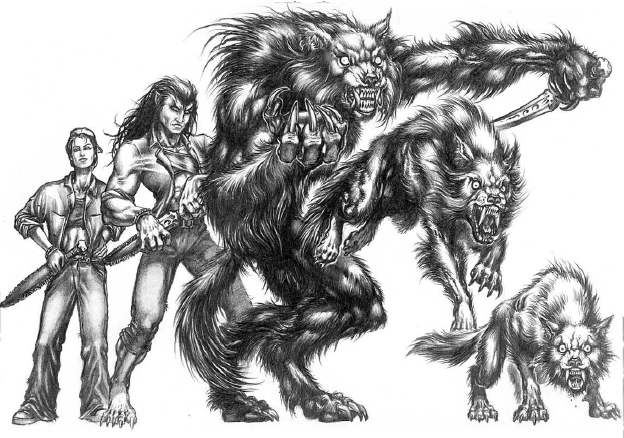
Behold, one of the most iconic pieces of W:TA artwork
Forms
Including Human and Wolf, werewolves have five forms. In order from "most human" to "most wolf" they go Homid, Glabro, Crinos, Hispo, Lupus. Homid is more or less human, it's the form Homid Garou are born in and the one they're most comfortable in. On the other end of the spectrum is Lupus , Garou in this form are unmistakably a wolf. While some lupus try to pass themselves off as 'feral dogs' they're either demented or a buffoon.
Crinos is the classic werewolf shape, and what Metis are born in. Nine feet tall, huge legs, massive claws on the end of long muscled arms, and gigantic powerful jaws. The book specifically calls out the Hugh Jackman Van Helsing movie as a good reference for Crinos Garou.
The in between forms are different. Glabro is the near-man form, described as an 'unusually tall feral person'. They double their weight and add between 6-inches to a foot to the homid height. They get hairier, brows slope, nails thicken and sharpen (not enough to do damage but enough to look menacing). It is also, as evidenced by the artwork above, really hard for artists to pull off correctly. It usually breaks down to "tall dude/woman with sideburns" or "really masculine looking woman". Hispo is the opposite, the "near-wolf" or dire wolf form. The Hispo is barely smaller than the Crinos and has even larger jaws. They range from 4 feet tall at the shoulder to 6 feet tall, which is larger than most draft horses.
Delirium
When a normal human sees a Werewolf in Crinos form, they're struck with overwhelming fear and madness. They either panic and run, faint, go catatonic, or blindly attack the Werewolf. This goes beyond the normal response of "holy shit giant wolfman with knives for fingernails", this is the Delirium. The Delirium is the result of supressed racial memories of the distant past when Werewolves and the other Changing Breeds regularly culled human herds to keep them in line. It's normally seen as a blessing, both for humans and Garou, as it keeps humans from figuring out what's really going on. Instead they rationalize it away as just a trick of the light or a bigfoot sighting, or they might not remember the exchange at all. Most humans are unwilling or unable to acknowledge that Werewolves exist, even when confronted with direct evidence. It is a rare and strong willed human that can look at a photograph of a Crinos-form Garou and not dismiss it as a hoax.
All of that aside, the Garou are loathe to take chances. Garou who use the Delirium like a magic wand that makes their troubles go away are severely punished or exiled. Werewolf survival depends on remaining hidden and keeping the humans ignorant of their existence, a condition they call the Veil. Werewolves and their human kin work very hard to make sure that any footage of a werewolf never sees the light of day. If even one human in a thousand believes what he sees, that's still 6 million humans. This occasionally results in bloody purges of humans who have seen too much, but the 'nicer' tribes refuse to allow innocent people to die because of Garou carelessness.
Kinfolk are immune to the Delirium. They have enough Garou blood in them to overcome the instinctual fear, which means the Veil does not apply to them. Some kinfolk are eager to help their cousins since they are able to operate in places Garou can not. Others are resentful because they're only called on when needed and aren't "true Garou".
I'm cutting the chapter in half since we're getting a bit long. You shouldn't have to wait a month for the next part.
Garou Society
Original SA post
Part 3: Garou Society
Now we're getting into more of the personal divisions of Garou society, what makes one Garou different than any other one.
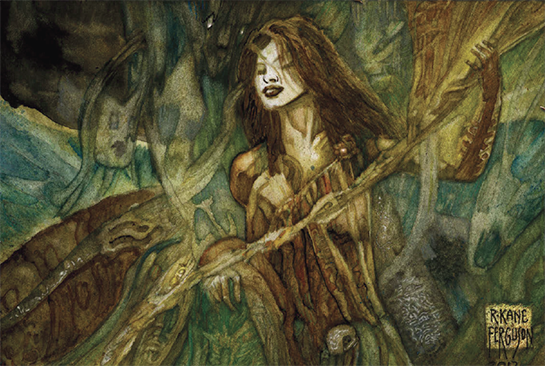
Auspices
Werewolves are tied heavily to the moon, and what phase of the moon they're born under determines their Auspice, or role that they play in Garou society. When a Garou sees their auspice moon in a month their rage pool is filled completely, though they are conversely more prone to frenzy during this time. Despite the division of the auspices, and the fact that there should be twice as many crescent/gibbous moons as there are Half-Moons, and twice as many of those as there are new/full moons, there's more or less an even distribution across the tribes.
New Moon: Ragabash Masters of stealth, trickery, and guile. Ragabash are granted the latitude to bend, or break, the rules of Garou Society. The logic being that if a rule does not stand up under scrutiny it shouldn't be observed at all. They're also called upon to do the kind of jobs that would make more honorable Garou blanch, like assassinations or recon.
Crescent Moon: Theurge Ritualistists, spirit-masters, and mystics. While all werewolves can communicate with the spirits, the Theurges are born to it. They act as emissaries to the spirit world, dealing with powerful umbral beings when the more confrontational Garou would cause issues.
Half Moon: Philodox Balancers, judges, and lawmakers. They're taught the Litany and all of it's interpretations from the moment they enter Garou society. They're mediators of disputes between Garou, as well as between Garou and Human society. The decision of whether someone or something can be saved or must be destroyed is often left to the Philodoxes.
Gibbous Moon: Galliard Storytellers and Lorekeepers. They're the ones who keep the oral history of their people, though in recent time that has sometimes adapted to multi-media presentations as much as it does howls on the mountainside. They can both whip their warriors into a frenzy and soothe tempers after a loss. They're also responsible for making sure that those worthy of glory find it, and those worthy of scorn don't escape it.
Full Moon: Ahroun Warriors, full stop. They're the deadliest and most vicious of their kind, and their gifts tend towards being better killers, or at least being more intimidating. They're often Pack Alphas but they've usually got a Philodox backing them up.
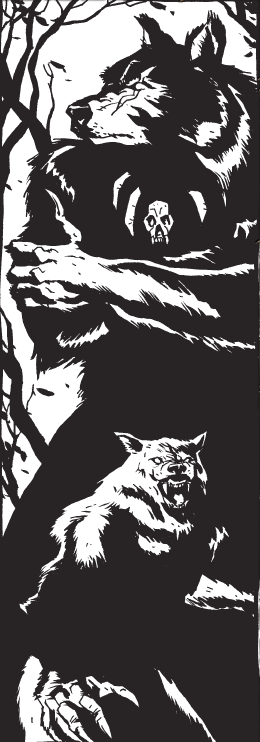
The Thirteen Tribes
Sixteen tribes agreed to the Concord, less the three that died in the interim that leaves thirteen. They tend to be divided up by their ancient homelands and kinfolk, though some time spent in the hands of bad writers have turned some of them into caricatures.
Black Furies: Hailing from ancient Greece, they see themselves as defenders of the sacred places of the wild. They're all-female(read: Amazons) though they sometimes accept Male Metis as full members of their tribe because they aren't "real men". Conversely they despise Female Metis because they aren't "Real Women." Their tribal totem is Pegasus.
Bone Gnawers: Once hailing from either North Africa or India, they've since spread around the world. They live with the poor and the destitute of every culture. Their tribal totem is Rat.
Children of Gaia: While they don't claim a tribal homeland ("all people are children of Gaia") they historically held territory in the Middle East. They see themselves as ambassadors of peace and justice. Unfortunately in some of their books they've become literal pacifist hippies. Their tribal totem is Unicorn.
Fianna: The best bards, the best drinkers, and the best warriors(at least in their mind). Originally Celtic, they're now very Irish. Almost to the point of parody. Their tribal totem is Stag.
Get of Fenris: Scandinavian and Germanic warriors par-excellence. Though most people ignore the "Scandinavian" and focus on the "Germanic", probably due to some of the tribe's association with the Nazi Party during World War II. They're unapologetic ally bloodthirsty and savage but they do their best to direct it to targets deserving of it. Their tribal totem is Fenris itself.
Glass Walkers: The other 'city tribe' along with the Bone Gnawers, Glass Walkers are adaptable and one of the only tribes to embrace technology rather than see it as a bad thing. They were historically centered in Italy and have had ties with the Mafia. Their tribal totem is Cockroach.
Red Talons: The Red Talons are an all Lupus tribe, no Homids allowed, and Metis only begrudgingly. They are strongly in favor of reinstating the ancient hunts against mankind, culling them back into a subservient position. Their totem is Griffin.
Shadow Lords: Hailing from Eastern Europe, they're the ruthless, Machiavellian, backstabbing tribe. They want to see themselves seated atop the throne of the Garou Nation but anyone who rises high enough almost invariably gets brought back down by the others. Their tribal totem is Grandfather Thunder.
Silent Striders: They were exiled from their ancient homeland of Egypt by the Vampires, now they roam the world. They run from place to place serving as messengers and scouts for the Garou.
Silver Fangs: The leaders of the Garou nation, revered by all(so they claim). They're a Russian tribe with a long history of pure breeding, nobility, and courage. Unfortunately this has lead to some narrow family trees and histories of insanity. Their tribal totem is Falcon.
Stargazers: Originally hailing from Himalayas, they’re a tribe of philosophers, monks, and mystics. They’re also one of the only tribes that has any real representation in the oriental areas of the world. Their tribal totem is Chimera.
Uktena: One of the two remaining Native American tribes, they’re the tribe of ‘dark mystics’, delving into magics that other tribes would balk at. This has allowed them to bind and destroy spirits that other tribes wouldn’t even recognize, unfortunately it has also lead to some of them becoming quite corrupted. Their tribal totem is Uktena.
Wendigo: While the Uktena have expanded and accepted non-native-americans into their tribe, the Wendigo are every terrible “Noble Native Warrior” trope rolled into one. There is, canonically, only one white Tribe Member, and that’s because their totem Wendigo himself intervened on his behalf.
The Litany
While the laws of the Garou may vary from tribe to tribe, the Litany is a constant. Passed down from ancient times by word of mouth, it is more an epic poem than a legal code. Chanting it in it’s entirety can take hours and the Fianna tribe hold annual contest to see who can recite it in the entirety without making a mistake.
Each of the thirteen precepts has a practical basis, but not all of them are as universally upheld. Some Garou, particularly amongst the more liberal tribes and younger members, learn how to bend the rules without breaking them when it suits them.
Garou Shall Not Mate With Garou
The first and some would say most important precept. This law forbids the creation of Metis because of their inherent deformities and insanity. Galliards have many “Tragic tales of werewolves who loved deeply and carelessly, only to be undone by their passion.”
The Reality-More Metis are being born today than ever, and it’s a self reinforcing problem. As more Metis are born and allowed to participate in society, people see it as less of a problem. Homids are increasingly prone to this as “modern ideals stress romance over arranged marriages for political gain”.
Combat the Wyrm Wherever It Dwells and Whenever it Breeds
The Wyrm is the source of all evil and corruption in the world. The Garou were created to protect the World and the Wyrm is it’s greatest enemy.
The Reality-Some jaded elders are more concerned with making sure that their time on this earth is comfortable and their political power is absolute. Few want to actually admit that the Apocalypse is happening as it would force them to abandon their dreams. Others claim that if the Apocalypse really is here, then they’ve already failed, and pissing in the ocean isn’t going to warm it up. There are also concerns over what constitutes a victory, killing a human being influenced by a Wyrm Spirit kills the human but leaves the spirit alive. Sure it’s quicker but it’s not as effective, and there are bigger battles to worry about.
Respect the Territory of Another
When one werewolf approaches another’s territory, ancient custom holds that they must announce themselves and ask permission before entering. The traditional method involves the Howl of Introduction, reciting one’s name, sept, totem, tribe, and home sept. And if you’re trying to enter a Shadow Lord or Silver Fang sept, your entire lineage.
The Reality- In the modern world, howling and urinating on trees is impractical. Particularly in urban caerns. Emails, telephone calls, and GPS tracking have supplanted the ancient howls. Also some younger Garou claim that territories should become more communally managed when they’re surrounded by enemies on all sides.
Accept an Honorable Surrender
Garou society typically settles its grievances with bloodshed. With a long dueling tradition, stressing trial by ordeal and single combat. Many Garou have lost their lives to overzealous practices, and while they died honorably, their losses were felt keenly. Any werewolf being attacked by another Garou can show throat to end the fight peacefully. They lose no honor in doing so, and the attacker is praised for their mercy and restraint. Theoretically they are all honor bound to accept surrender.
The Reality-Unfortunately frenzy exists, and that doesn’t help matters. There are also some Garou who go around openly antagonizing people and then showing throat to try and bait them into losing honor. And there are some who ignore it entirely “accidentally” in order to take out potential threats.
Submission to Those of Higher Station
Garou society maintains a strict Hierarchy, as much as a worldwide society of human-wolf-brains can manage. A werewolf must always honor reasonable requests from higher-ranking Garou.
The Reality-Too many elders no longer understand or can’t cope with the human world. And ask requests of younger Garou that range from stupid to suicidal. Each tribe has it’s own culture and not all of them are keen on kowtowing to tyrants or humoring egotistical alphas just because they can recite their lineage back to Falcon himself. Red Talons refuse to acknowledge that there is a complicated hierarchy and that any Garou that doesn’t “instinctively Understand” their place is a fool and deserves punishment. Silent Striders and Children of Gaia respect personal choice, and prefer to earn respect rather than demanding it. Get of Fenris only respect those that can best them in combat. Shadow Lords and Silver fangs, however, enforce this Tenet to the letter.
The First Share of the Kill for the Greatest in Station
The “Kill Clause” originally applied to hunting, but has been expanded regarding all spoils of war. In theory, the most renowned Garou has the right to the most powerful toys. Silver Fangs and Shadow Lords demand what they see as their due, other tribes accept grudgingly.
The Reality-The Alpha that takes everything for himself weakens the pack as a whole, or so the modern thinking goes. Trickle down theory only works when things actually get distributed downwards rather than hoarded by Elders who see it as their right. Most modern packs are egalitarian or democratic in their thinking, but they at least pay face to this law when they can, trusting for the Alpha to defer to the pack’s wisdom.
Ye Shall Not Eat the Flesh of Humans
In ancient times, shortly after the Concord, a group of Garou found that humans tasted really good, and gorged themselves often. Growing fat off of humanity they were unable to hunt the Wyrm Spirits that they should have been killing. So this law was implemented as a bit of practicality. Nowadays though, humans eat so many preservatives, drugs, and other Wyrm tainted filth that eating them is genuinely a bad idea.
The Reality-Some werewolves are desperate enough or insane enough to ignore this tenet, they usually act alone or in packs of like minded Garou and even if they’re lucid they’re pretty insane.
Respect Those Beneath Ye - All Are of Gaia
As the protectors of the world, Garou should respect every creature’s place in the world. Traditionally they’ve practiced an “animistic and warrior version of Noblesse oblige, and chivalrous behavior is a respectable way to gain Renown.”
The Reality-This tenet isn’t always enthusiastically enforced. Shadow Lords and Get of Fenris often only pay out as much “respect” as has been “earned” by the target. Bone Gnawers don’t respect anyone as no one could be lower than them, and they get no respect from anyone.
The Veil Shall Not Be Lifted
Garou existence must remain secret. And this goes far beyond respect for the Concord or humanity’s right to it’s own society. Humans have guns, lots of guns, and Werewolves are not invincible. If they return to the days when they were the monsters in the shadows, humans will hunt them like the beasts they are. And the Delirium is not a magic shield, the stories that humans concoct to cover up their experiences can often be as damaging as a rampaging Wyrm Beast.
Do Not Suffer Thy People to Tend Thy Sickness
The Warrior who cannot fight or hunt weakens those who must care for him. In ancient times an infirm, aged, or mortally wounded Garou would be torn to pieces by his septmates. These days the merciful practice is to let such an Elder choose how to end their own life. In legends they would set out on a journey and never return.
The Reality-The Children of Gaia despise this law and care for their elderly until their natural death. A few older Garou, crippled by depression or remorse, abandon Garou society and return to human or lupine lives, making peace with what they’ve left behind.
The Leader May Be Challenged at Any Time During Peace
A weak Alpha should not be tolerated. If no immediate threat is nearby, any Garou of sufficient rank may challenge the pack leader for his position. In a pack this might be a quick duel, battle of wits, or intimidation display. In a sept this can turn into high ritual.
The Reality-Many tyrannical leaders rule by simply being too tough to defeat, requiring an entire pack to systematically wear them down. Other declare a constant state of war, not allowing for there to be a “peace” at which to challenge him. Others bend the rules so that the duels are always in a venue that favors them.
The Leader May Not Be Challenged During Wartime
Ask any military leader what would happen if you decided to just shuffle the chain of command mid combat and see what would happen. Once a fight begins an Alpha’s word is law, anyone who disobeys is punished once the danger is passed, if they’re still around to punish.
The Reality-Again “Eternal War” is a common tactic to keep bad Alphas in power. Those who disobey usually have a chance to defend themselves at a tribunal, particularly if their actions saved a pack or a sept, or the Alpha was startlingly incompetent. But any valor that would be won from the act is cancelled out by the insubordination.
Ye Shall Take No Action That Causes a Caern to Be Violated
Caerns are the lifeblood of Gaia. Whenever one is corrupted or destroyed, part of the Earth dies, along with it a part of the Garou.
The Reality-The Garou have a special rite that slowly transforms a targets bones to silver, causing them to burn through their own flesh and die a slow, agonizing death.
They use it on people who violate this Tenet.
Justice
To keep the law, you need to be willing to enforce it. And the Garou code of punishment ranges from simple reprimands for minor crimes and mistakes to elaborate trials or ordeals for complicated transgressions. Loss of Renown is a common punishment, but when the Litany is violated, the consequences can become severe.
Each sept and tribe have their own customs. Get of Fenris and Red Talons prefer trial by combat. Shadow Lords prefer cunning, elaborate arguments, ensnaring with words and intimidating into silence those that try to circumvent the process. Bone Gnawers hold a traditional trial by a jury of peers. Uktena summon spirits to discern the truth. Glass Walkers employ modern criminology. When two or more tribes are involves, the ones of highest rank or the elders of the offended tribe get to choose, either option can raise hackles.
Once a sentence has passed, a sept enacts a formal rite to punish the offender. If a criminal escapes, the Garou may offer a bounty for his capture, or skin. The worst punishment is formal ostracism, exile. Garou believe that their great heroes are reborn, some even have visions of their past lives to prove it. Those that are outcast are Ronin, shut out forever from this cycle, and from their brothers and sisters. Unless they perform a great deed to prove their valor, they will live out their lives and die mistrusted and alone. Some fatalistic Ronin believe there is no hope and form packs of Ronin, rejecting the Litany entirely.
Hierarchy
In small gatherings, a leader can prove their dominance by brute force if it is necessary. In larger groups, an Alpha that is forced to defend themselves against every challenger will soon be too weak to govern properly. Thus Garou society established a system of Renown, a measure of a hero’s deeds and service to their sept. Infighting wounds and weakens a sept, but this system channels those energies in a positive direction. While it might seem abusive and unequal to modern Garou, putting those who display honor and wisdom in positions of power tends to encourage those traits in those beneath them. Based on their renown, each werewolf also holds a certain Rank in Garou society, and they are often addressed by their proper title.
-
Cub
- the bottom of the pecking order, treated as little more than children. Eager to learn and prone to confusing questions.
-
After completing their Rite of Passage, a cub becomes
Cliath
, and they are enlisted to perform tasks for their sept and sometimes the nation as a whole.
-
Eventually they progress to
Fostern
. They have enough rank to act as emmisaries between septs, and sometimes packs of Fostern undergo periods of fosterage in other Caerns to learn different ways of doing things.
-
Adren
outrank fostern, by this time they’re usually able to take on one of the lesser political positions in the sept. Packs of Adren usually limit their travel to a few septs as political rivalries emerge.
-
Athro
are typically swept up in the most perilous tasks the Garou nation can offer. High enough in rank to be valuable, but not high enough to be too valuable to lose.
-
Those Garou become
Elders
, even if they don’t hold a leadership position in their Sept they’re afforded the greatest respect the nation can offer.
When two Garou of differing rank interact things usually go smoothly, the Litany dictates how they should act. When two Garou of roughly equal rank interact though, the niceties aren’t quite so clean cut. If heroes of equal status disagree they can quickly come to blows, which is why the complex system of challenge and tests of dominance has been developed to keep them from killing each other.
There are three main forms of testing dominance, Facedown, Gamecraft, and Duel. Facedown is basically a staring contest. The challenger growls and locks eyes with the opponent, first one to back down loses. It’s still fairly dangerous as they might work themselves into a frenzy and attack, which causes them to lose the challenge and Honor. Unfortunately you’ve now got a frenzying werewolf that just lost a duel on your hands. Gamecraft is a test of skill, cunning, or wits. It might be a riddle contest, a game of chess, a test of knowledge, or some similar mental exercise. The winner is the one who displays superior intellect, or cunning/willingness to cheat in the case of Ragabash. The Duel is straightforward single combat, rarely to the death unless frenzy takes over. The loser in any case is required to surrender, either by showing throat, bowing, knocking over their own king, or being battered down by the winner until they’re too beaten to do anything else.
Leadership can pass from one Werewolf to the next depending on immediate need, if a battle in the physical world gives way to negotiations with wronged spirits, an Ahroun may find themselves supplanted by a Theurge after a quick riddle contest. At the pack level such cursory challenges are rarely needed as packmates are intimately aware of everyone’s strengths and failings.
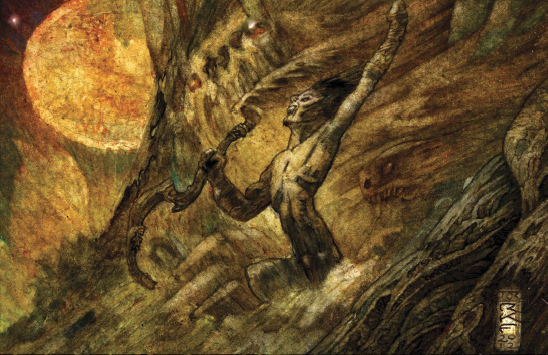
Social Divisions
The Pack
Packs range in size from two to ten werewolves. Preferably each of the five auspices have at least one representative but necessity may require otherwise. Frequently packs are just thrown together out of whatever young packless Garou are at hand and thrown at a task, those that come back might get put into other Packs or have surviving members reinforced.
Each pack shares a common purpose, this might be a simple declaration(“Protect our Sept”), an ambitious crusade (“Recover Lore of the White Howlers from the Dens of the Black Spirals”), or something more esoteric (“Travel to the East and share knowledge with other supernatural creatures”). They may perform other tasks in the meantime but their cohesion comes from a unity of purpose. Packs often quickly realize where their strengths lie, and focus in that area. Some are better at monkeywrenching than others. Others are spirit world explorers. Elders quickly realize where a packs strengths lie and direct them down those paths
Totems
Each pack also dedicates themselves to a particular totem once they are formed. Most of these are animal spirits, such as Raven or Bear. Others are elemental spirits like Grandfather Thunder or mythic spirits like Pegasus or Chimera. They may also follow an animistic incarnation of an ideal like the Muses or the Almighty Dolla. Totem spirits guide their pack and guard them, even lending a bit of their spiritual power. When the pack disbands, they release their pack spirit in a ceremony and with it their bond.
The Sept
Septs are the societies that form around Caerns, usually for the purpose of defending them. The oldest septs are dominated by one or two tribes and are not found far from their homelands. Modern septs are increasingly multi-tribal, hoping that the strength of diversity will compensate for dwindling numbers. The primary task of a sept is guarding the caern. Using the power of Luna, Moon Bridges can be formed between the largest caerns, allowing for instantaneous transport from one sept to another. Because of this, septs are often gathering places for travelers. The elders of a sept may welcome a wandering pack, allowing them a place to rest and perhaps granting some resources for their errand. In return they ask for Chiminage, usually in the form of a story of their journey, but sometimes as esoteric as bringing back something valuable from the nearby spirit world, or performing a task for the septs benefit.
Older Garou usually settle down in one sept that they favor, assuming a political position there. Every sept has a Sept Leader, the overall master (or “True Alpha”) who organizes the sept and directs the local packs. The highest ranking Theurge becomes the Master of the Rite. They perform the day to day rituals that maintain the sept, and care for the spiritual center of the Caern where werewolves meditate. The Caern Warder protects the area surrounding the Caern, known as the Bawn, and keeps an eye out for trouble. They’re usually assisted by the young metis of the Sept. Some larger septs may have a Den Father or Mother that cares for all the cubs. or a Talesinger responsible for maintaining the Sept’s History.
The Tribe
The most overarching social unit is the Tribe. The Tribe’s bonds are familial and ideological, and inspire loyalty and schisms in equal measure. Each one has a very different hierarchy, from the nobility of the Silver Fangs to the meritocracy of the Glass Walkers. Young werewolves serve their pack first and their sept second, but when matters of tribal importance arise elders sometimes tap Cliath to serve, bringing their packs along for the ride. Some tribes place extra pressure on the need to obey, and all offer Renown to those loyal enough to serve.
Within the Tribes there are also Camps , which are smaller groups of werewolves that share a common goal but not necessarily the same pack. The Glass Walkers, for instance, have the Mechanical Awakening which seek to find a true intelligence within the machine and the Dies Ultimae who fight pragmatically with modern military tactics and equipment. Camps are loosely distributed and rarely do entire packs of one camp form.
Moots
Moots are Garou gatherings, events that serve a variety of social, political, and religious functions. They reinforce common ties amongst Garou by emphasizing ritual, purpose, and camaraderie. They usually occur once every full moon, or whenever there is need for a specific gathering. The Moot is also where werewolves earn their renown by telling tales of their deeds, so it’s rare to find someone intentionally skip them. They always take place at caerns and the spiritual energy expended at such grand rites help keep the Caerns alive. There are a couple of different kinds of Moots. Hearings are basically just quick debriefings when a pack returns from an adventure. To reward renown, share news, and keep elders abreast of what’s going on. Sept Moots are the monthly meetings of a sept. All Garou are welcome but outsiders, particularly of an unrepresented tribe, are viewed with some suspicion. After the usual airings of grievances and ritual they usually end with a grand celebration. Grand Moots are tribal events, and only called when there is a matter that concerns the entire tribe. All werewolves of the tribe within a reasonable distance are required to attend. Concolations are the largest moots, called for only the most serious of purposes. All werewolves nearby regardless of sept, tribe, or pack are required to attend. After it is announced by agreement of at least five elders of at least five different tribes, it is held three months later to allow for news to spread and people to gather.
The book goes on to describe the various kinds of Tribal Moots but it can basically be inferred at this point (Fianna drink and sing, Get drink and fight, Glass Walkers hold board meetings or raves, Red Talons slaughter humans and use their entrails to decorate Christmas trees) so I won’t go into detail.
All Moots, however, tend to end with a Revel. In rural caerns all Garou present assume crinos form and run madly about the bawn, clearing away anything that may pose a threat. In urban areas this is usually sublimated to a pub crawl or a party of some kind.
Language
Besides the many human languages, and the instinctual communication of the wolves, the Garou have developed their own language known as the “High Tounge”. Garou language depends as much on body language and tone as actual words, accentuated by growls and whines. The more complicated concepts are impossible for Garou in Homid or Lupus form to even enunciate, requiring at least a partially transformed voicebox to form. Garou in Lupus or Hispo form can communicate freely with wolves, instinctively. A freshly changed Garou can go lupus and communicate with wolves freely but probably inelegantly.
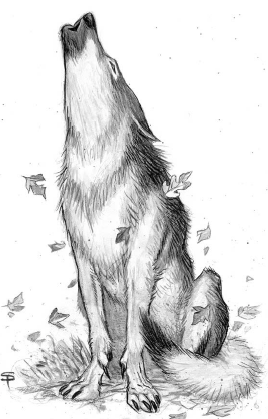
There are also a bunch of Howls called out here, like the “Anthem of War” or “Curse of Ignominy” that all have various uses, most players will never touch any of them or if they do will usually just go “I’m howling to do X thing”, looking it up if it’s important. One deserves special mention, the Cry of Elation, which implies an impending act of great Glory. It’s essentially Garou for “Hey! Look at me! I’m about to do something stupid!”
Rage Across the World
I’m only going to be giving cursory explanations of the continents because they actually released a new supplement that goes over them in more detail. And either I or someone else will be going over that soon enough I’d wager.
North America
Every tribe has representation here, as almost every tribe has followed their kin as they immigrated. The arrival of the newcomers wasn’t always the nicest on the native Garou, as evidenced by the death of the Croatan, and the pure tribes haven’t fully forvigen the rest of the Nation for what they’ve done. They take effort to point out that the “most pressing contemporary form of Wyrmish poison in North America is Fracking.” Because in the World of Darkness all Fracking is done only on ancient Wyrm prisons and they’re using toxic chemicals to wake them up!
South America
Some Uktena settled here but there were very few Garou until the European colonization. Still the Garou are few and far between as there is little if any native wolf stock for them breed with. One of the most notable things about South America is that there is a loose confederation of Garou and the other Changing Breeds fighting against Pentex in the “Amazon War”, what makes it notable is that it has been spearheaded by a Get of Fenris named Golgo Fangs First. And a Get Peacemaker is about as unlikely as you can get.
Europe
Most of the tribes have come from here, but as the forests have been choked out and wolf territory dwindled there really isn’t much room for them to hide anymore. Supposedly the financial collapse in Greece was perpetrated by the Wyrm.
Africa
This will get addressed in much more detail in the Changing Breeds write up, but there’s a strong confederation of changing breeds, including the Garou, here in Africa. Northern africa is somewhat more hospitable to the Garou than most other areas, and the Silent Striders homeland was in Egypt before they were driven out by the Vampires.
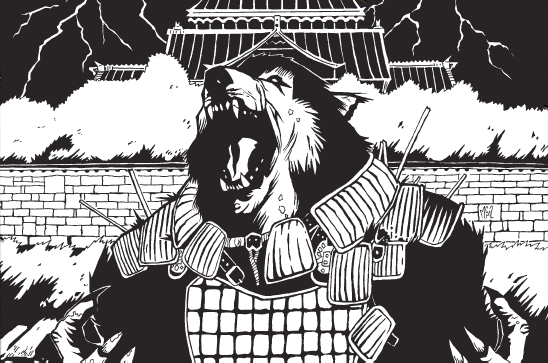
Asia
The Far East will also get expanded on in the Changing Breeds write up. But there are strong concentrations of Garou in Japan and India, with large red talon populations in Mongolia and rural china.
Australia
Australia is still a pretty miserable place to be a Werewolf. The spirit world hasn’t recovered from the death of the Bunyip. There are Werewolf populations on New Zealand trying to keep the wild places healthy
Antarctica
Hahahahaha, no.
The Triat
The Wyrm
As savage as the Garou are, the Wyrm is worse. The Get describe it as Jormungandr, the Bone Gnawers see it in the poor forced to fight to survive in filth and squalor, the Black Furies see it in families devastated by domestic violence and abuse. None of them are really wrong. While it’s actual incarnation is trapped in the deep umbra, three pieces of it have splintered off and formed what is known as the Triatic Wyrm. The Beast-of-War gluts on violence, destruction, and entropy. The Eater-of-Souls seeks to devour all of creation, matter, energy, and spirit. The Defiler Wyrm is a force of raw corruption and Violation
As the Garou have Caerns, so does the Wyrm. Some are tainted Gaian caerns, others are newly opened as sites of great polution awaken into spiritual sentience. But more often than not they are subtle, there are no warning signs, there are no overt guardians. Their locations are marked by fallow fields, children born wrong, sullen xenophobic communities that do not know how ruined they really are.
The Wyrm’s spirit Servants are known as Banes . Like all spirits they must follow their nature, and their nature is defiled and polluted. Some are feral, some are intelligent, are all instinctively loyal to their dark father. Powerful banes can possess humans or animals in the physical world, using them as vessels. Typically these vessels have already been weakened by their depredations in the spirit world, or already have a predilection towards violence, lust, or greed. Once they’re possessed the whispers turn into urgings, and the more they corrupt and defile the more their physical forms begin to warp and twist, turning into nightmarish beasts.
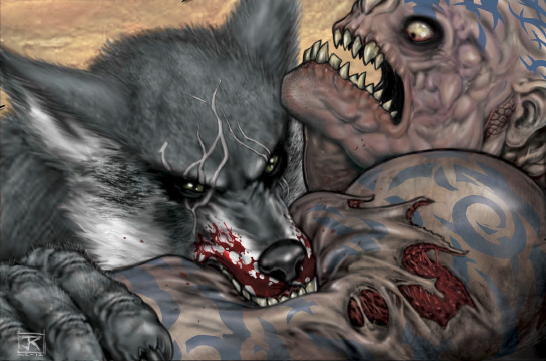
These are known as the Formori , their mutations are almost universally designed for pain and bloodshed, and while a single Formor is easy enough for a single Garou to kill, they too run in packs, sometimes numbering in the dozens. And while many of them are mutated beyond recognition, some are just human enough to make you hesitate to kill them, and that’s exactly what they want.
The Black Spiral Dancers are perhaps the Wyrm’s greatest servants, the fallen White Howlers and their descendants that followed the Wyrm into his deepest pits. For almost two millennia they have waited and spawned in the tunnels deep beneath the earth, worshiping balefire and radiation. Yielding crinos forms with sharklike teeth, leonine or batlike ears, and gray-green fur. Each Black Spiral Cub is dragged to the realm of Malfeas, deep within the realm of the Wyrm, and forced to walk the spiral labyrinth containing unimaginable horrors. Those that survive and return to the surface are changed forever. Many are reduced to frothing berserkers, but others are still quite functional in their madness. They can still form plots, infiltrate, and seduce other Garou into their master’s service. Unlike banes they still have free will, unfortunately it is a will devoted entirely to the Wyrm’s service. The Tribal Totem of the Black Spiral Dancers is Whippoorwill.
The most mortal of the Wyrm’s Pawns is the megacorporation known as Pentex . Originally just an oil company they’ve got their tentacles in everything now, Magadon Pharmaceuticals, Endron Oil, Sunburst Technologies, O’Tolleys Restaurants, and the Black Dog Game Factory just to name a few. It consumes the resources of the earth and spits them out as consumer goods tainted by the Wyrm. While many Garou are aware of their subsidiaries and their corruption, very few know that they’re all owned by one company. And Pentex likes it that way, their anonymity protects their monopolies in many areas of the world. Their prime agenda is weakening human society and the world at large, paving the way for the Wyrm to claim precedence.
The Weaver
The Weaver created the structure of the world, from the mountains to the depths of the ocean. She gave birth to a host of spirits to help keep order. She weaves the webs that keep reality in place, but she has been weaving them thicker as of late. The subtle machinator is just as much of a threat. While the Wyrm grows as a cancer upon the world. The Weaver is slowly smothering it beneath a bevy of webs. Each power line laid down, every road paved, is another mark in the Weaver’s win column. And she’s also much harder to stop. Outright anarchy and destruction weaken the Weaver but feed the Wyrm, to say nothing of rending the veil and inviting retribution from humanity. The most effective tactics involve delving into the areas in the spirit world where she holds sway, killing the denizens that live there, and weakening the strands surrounding her strongholds. This can often be just as dangerous, if not more, than fighting the Wyrm. It’s only recently that septs have started to realize the Weaver’s danger, and more of them howl the glory of those who have defended the Caern against her steely webs.
The Wyld
The Wyld is. There’s really no other description for it. It is growth, life, chaos, rebellion, and primal instinct. While the Wyrm and the Weaver seem to have agendas that we can understand, the Wyld does not. Invoking the great spirit servitors of the Wyld is as likely to help you as kill you, but still Garou try. The Wyld is still a powerful force, even if it must struggle to get through the Weavers Webs it’s a part of the Triat, it’s just not very motivated to do anything other than what occurs to it right at that moment.
At this point the book includes it’s obligatory vocabulary lesson, which includes a lot of terms that very few people will actually use. So here’s a picture from that second presented without comment.
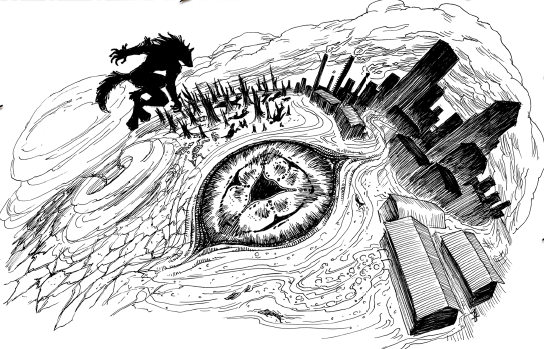
Next: We start character creation.